Content Decay Is Your Hidden SEO Killer (And How RECEIPTS Stops the Rot)
Content decay doesn’t announce itself — it quietly drains visibility, authority, and trust. Relato’s RECEIPTS framework turns fact-checking into a living system that protects your rankings and reputation over time.
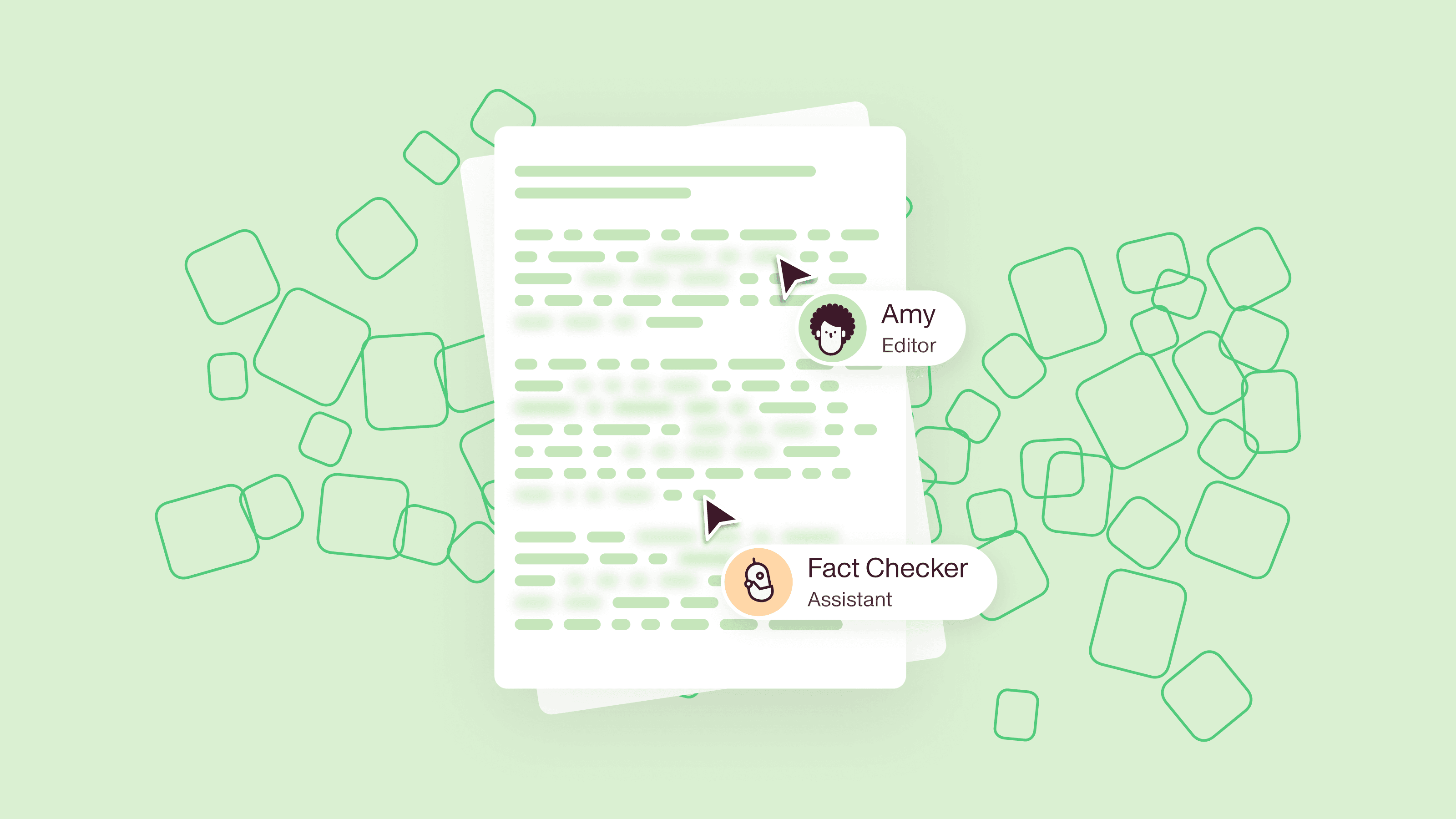
Remember that brilliant article you published in 2022? The one that brought in tons of traffic?
Yeah, it's probably sending people to your competitors now.
Why? Those stats you quoted are three years old. The companies you mentioned got bought out. And those regulations? They changed last quarter.
The problem with content decay is that it creeps in quietly. Rankings slip from position 2 to 5, engagement dips, and before you notice, the page is buried. People land on your page, see outdated info, and bounce straight to whoever has fresher facts.
And, unfortunately, this might be happening across your entire content library right now.
You probably end up frantically updating whatever's on fire today. But what if you could spot decay before it spreads?
That’s where the RECEIPTS framework, developed in-house at Relato, comes in. It’s our AI-powered method for catching and preventing content decay across your library — before it costs you rankings, credibility, and hours of manual QA.
The true cost of content rot
Content decay costs you traffic, damages your brand's credibility, wastes your team's resources, and signals to Google that your site can't be trusted. The fix isn’t rewriting everything — it’s spotting what’s losing relevance before it pulls the rest down.
SEO erosion: How outdated content drags down your entire domain
If your site has a substantial amount of outdated content, Google can downrank your entire domain — even your fresh, high-quality pages.
During helpful content recovery audits, SEO experts consistently find pages featuring stats from 2016 or missing significant recent events related to their topics. These stale pages drag down domain authority.
The algorithm treats outdated information as a quality signal. When Google crawls your 2021 article claiming "remote work is temporary" or citing pre-pandemic statistics, it questions everything else you publish.
Your outdated content becomes an anchor that drags your entire site underwater.
Trust erosion: The credibility death spiral
A visitor reads your article citing a "recent study from 2019." They check the date — it's 2024. They close the tab and never come back.
It’s a common problem that content marketers and writers face. Content writer for B2B SaaS, Juliet John, for example, faced the exact same issue:
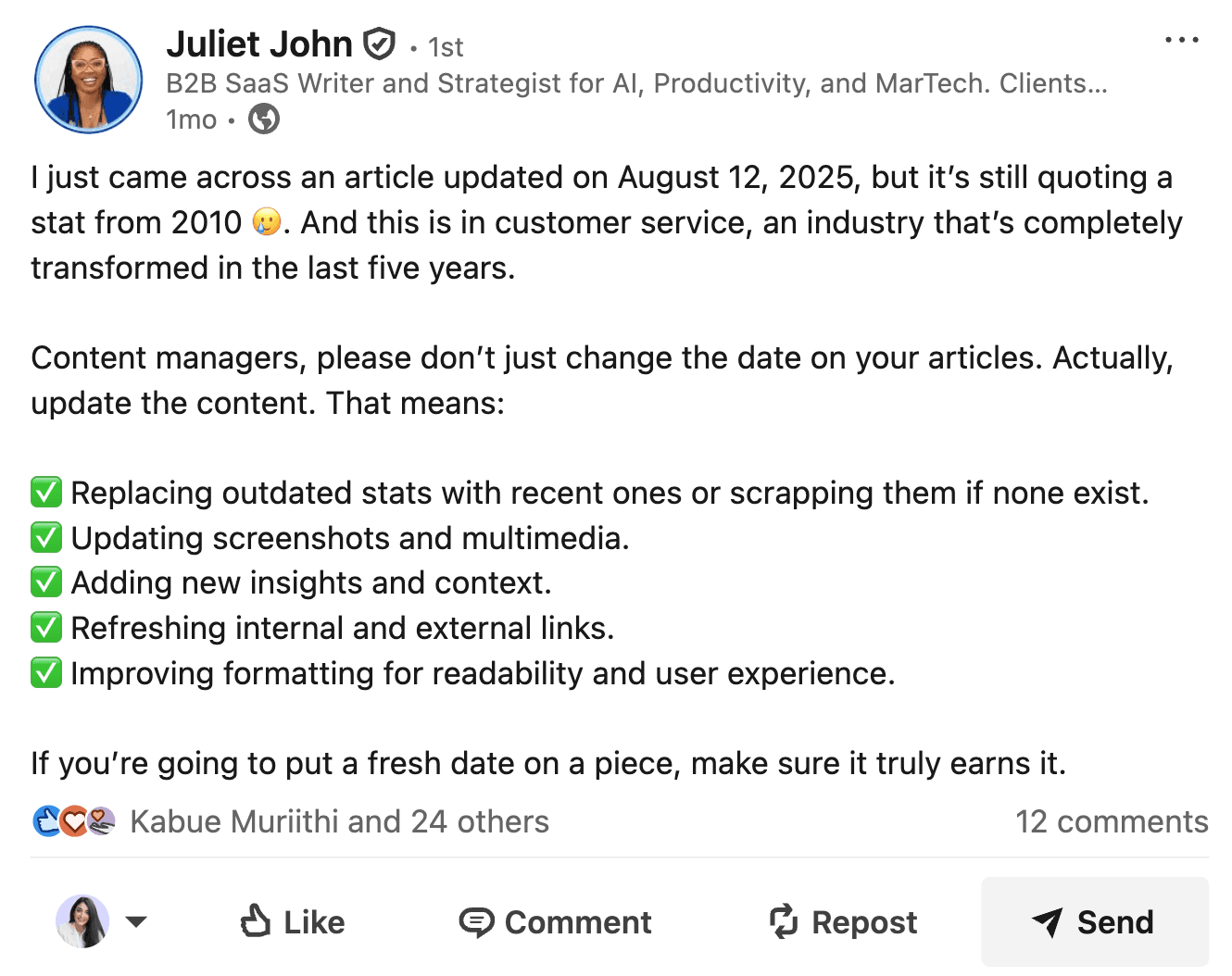
Outdated content creates a rabbit hole of broken trust. When readers spot one outdated fact, they start doubting all the other facts in the piece. They screenshot your old statistics and share them on LinkedIn as examples of lazy content and tell their team to find better sources.
Opportunity cost: Bleeding resources while missing growth
Every hour spent panic-fixing broken content is an hour not spent on strategic initiatives that help you scale your content program without sacrificing quality. Your team scrambles to update statistics instead of launching that new content series.
According to CMI's 2026 B2B Content Marketing Trends report, 39% of marketers cite resource constraints (time, people, and budget) as a top content challenge.
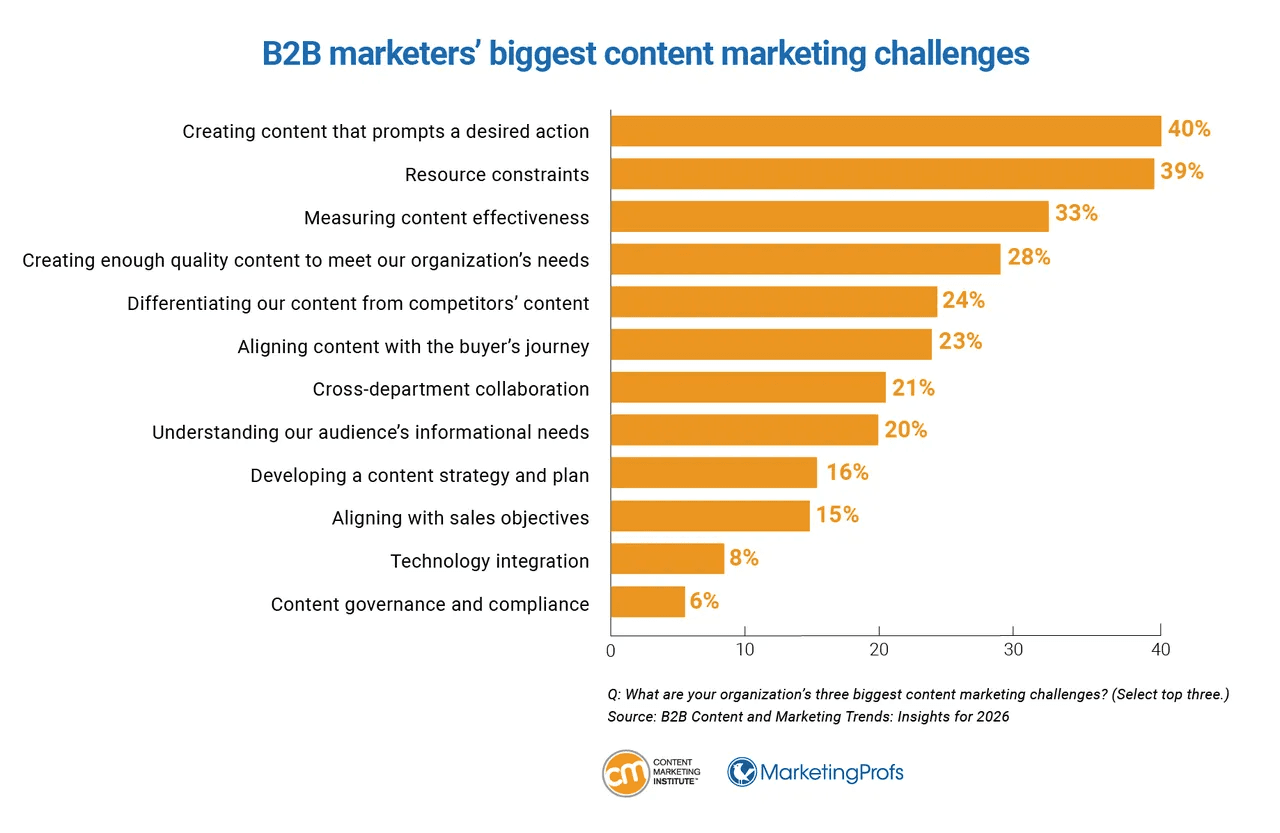
When you're manually checking hundreds of pages for outdated stats, broken links, and stale claims, you're burning through exactly the resources you don't have.
If it takes three hours to audit one outdated post, a 200-post library equals 600 hours of reactive cleanup. That’s 15 full workweeks lost to maintenance that should have been automated.
Why traditional fact-checking fails at scale
Traditional fact-checking was built for a different world — one where sources stayed put and facts had longer shelf lives. Think academic papers, not SaaS blogs.
Whether it's the CRAPP test used in universities or manual review processes, these methods work fine when you're evaluating a handful of static sources in a controlled environment.
But content marketing moves too fast for manual verification. Your top-performing articles cite sources that shift constantly:
- Annual industry data with a shrinking half-life
- Pricing, product names, or logos that update without warning
- Legislation that changes in response to real-world events
- Companies that merge, rebrand, or shut down altogether
Traditional fact-checking happens at a single point in time. You verify a source today, mark it as credible, and move on. But what happens three months later when that "recent study" is no longer recent? When that company you cited pivots their entire business model? When those regulations get overhauled?
That polished piece from 2022 might have been perfectly fact-checked when it launched. Every claim verified, every source vetted. But now three of its key facts are outdated, and you only discover the decay after rankings fall or a sales rep flags a complaint during a client call.
Static evaluation tools can’t support continuous accuracy across a growing content library with shifting references, statistics, and claims.
The problem compounds when you consider that 28% of B2B marketers already struggle with creating enough quality content to meet their organization's needs. Now imagine adding manual fact-checking to that workload — checking every stat, verifying every source, updating every outdated claim across hundreds of pages.
What you need is to build content systems with AI that monitor quality over time.
Enter RECEIPTS: The framework built for content health
RECEIPTS stands for Reliability, Evidence, Context & Currency, Expertise, Independence, Precision, Traceability, and Significance & Sensitivity.
It turns static fact-checking into a continuous, AI-driven audit that detects, scores, and prioritizes content risk before readers (or Google) notice.
Here’s what it includes:
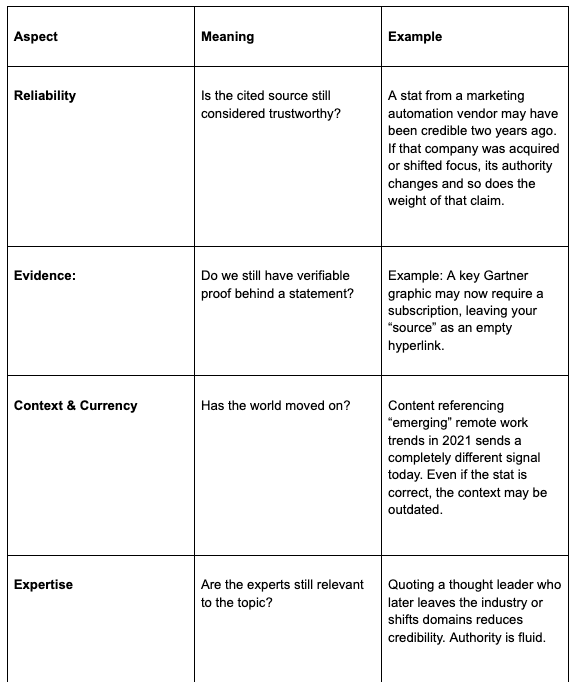
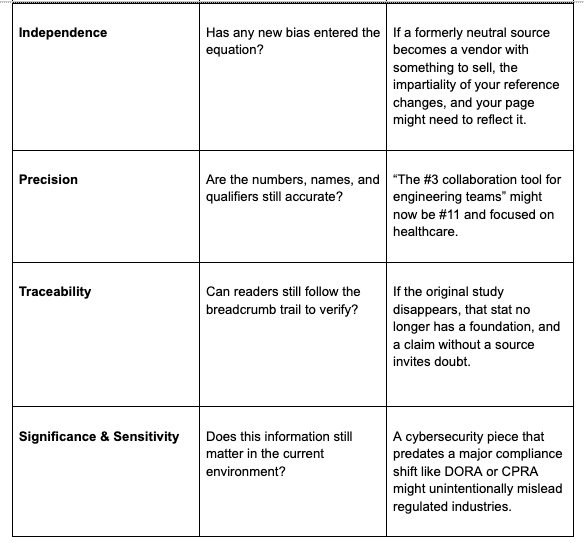
How the Fact-Checker Assistant makes RECEIPTS scalable
Running the RECEIPTS framework manually makes sense when your blog has ten or twenty pieces. You can open each one, check sources, verify stats, and confirm that nothing’s gone stale.
But once you’ve been publishing consistently for a few years, that same process becomes unmanageable. A content library of 300+ pages means thousands of data points, links, and claims that can quietly expire without warning. By the time you discover one outdated reference, dozens more are already eroding trust and rankings.
That’s why we built the Fact-Checker Assistant at Relato to make RECEIPTS scalable.
Here’s how it works.
1. Paste a URL to start
Begin by dropping a page link into the agent.
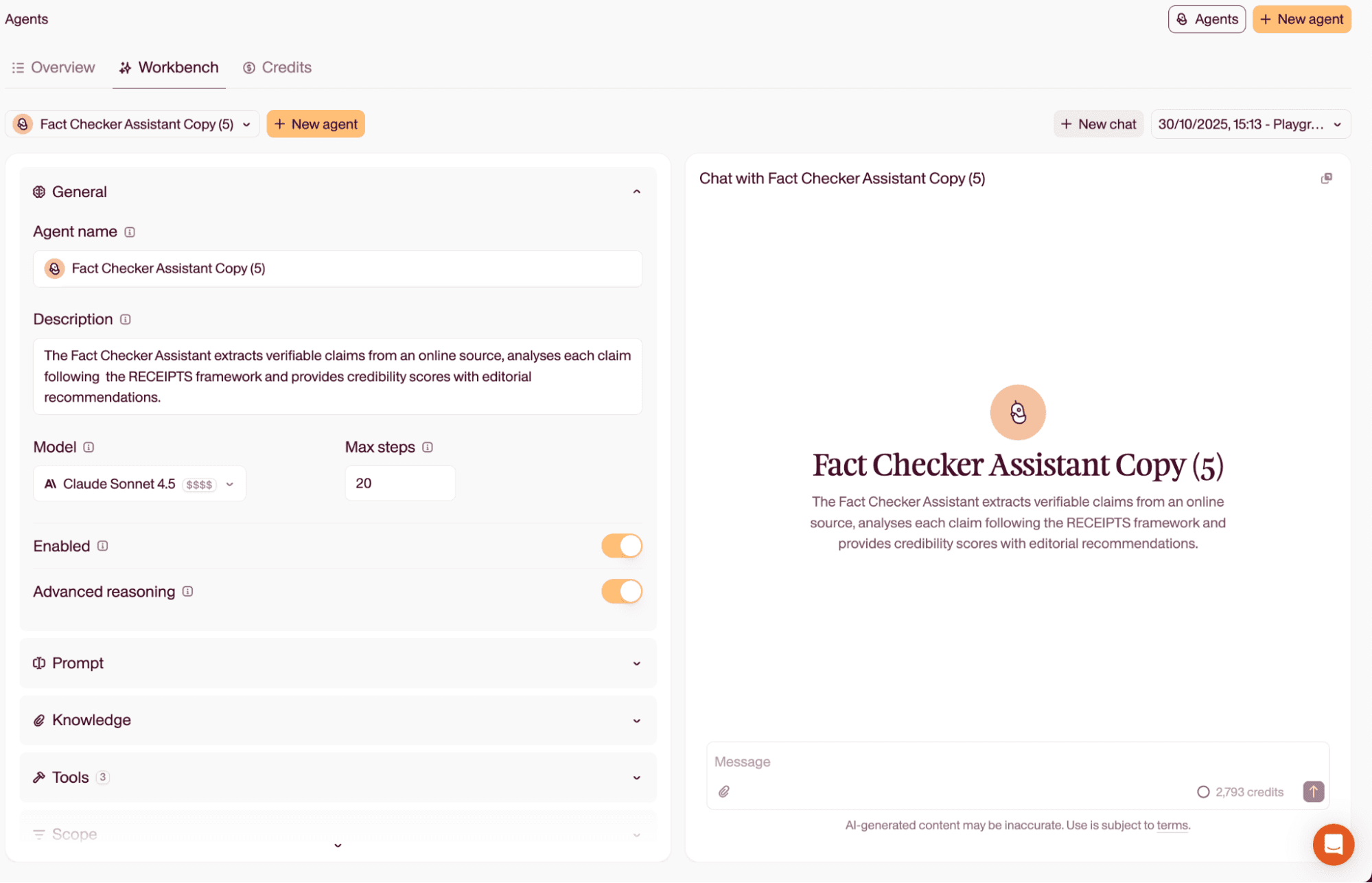
For this preview, I’ve used an article from Toggl on recruiting on Facebook, which was published in 2023 and updated in 2024.
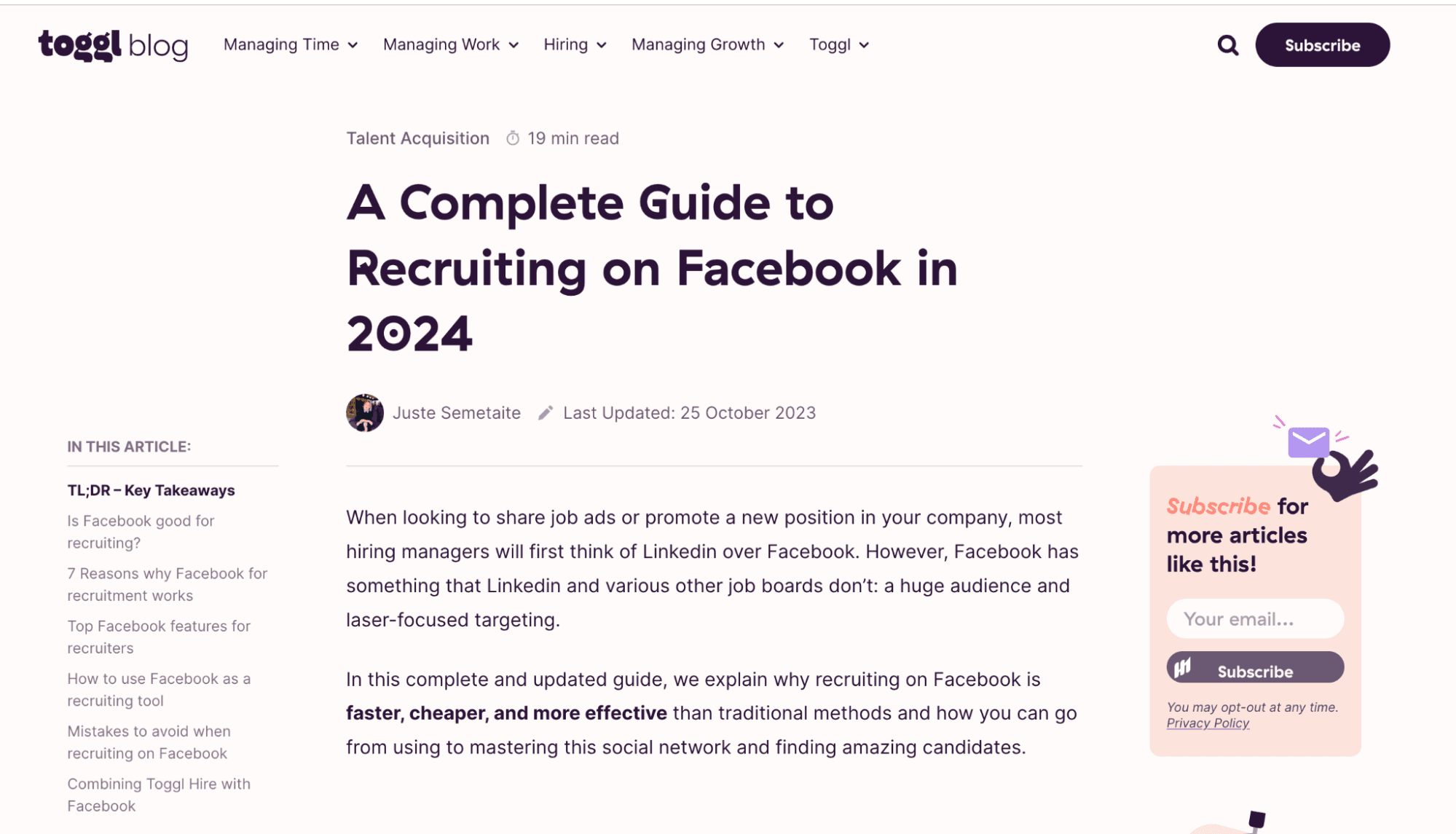
The agent fetches the live version of the article so the review matches what readers see. Working from the live page keeps the findings accurate.
2. The agent pulls the content and extracts verifiable claims
After it loads the page, the agent looks for statements it can check: counts, percentages, monthly actives, rankings, prices, named entities, dates, and cause-and-effect claims. This is where you use AI for research to verify facts at scale rather than relying on manual spot-checks. It ignores opinion and setup language.

The agent conducts research on each claim to locate primary sources.
3. Each claim is scored against RECEIPTS
For every claim, the agent scores it across all eight RECEIPTS elements, on a 1 to 10 scale, then averages them.
The numbers make risk visible. For example, the Facebook claim scores 9.0 overall with high marks for Evidence and Traceability, which suggests it’s still solid. By contrast, older traffic estimates for Monster and CareerBuilder score under 5, with low Context & Currency and Precision.
You don’t have to debate which one to fix first since the scores point you there.
4. You get an “Editorial Advice” view tied to each claim
Next, the agent translates the scores into an action and adds notes with links. Actions are simple:
- Keep as-is
- Revise
- Remove or update

The editorial actions shorten the path from “this might be off” to “here is what to do.” For example, “Facebook has more than 3 billion active users” is marked Keep as-is with multiple supporting sources. “LinkedIn has 424 million monthly active users” is marked Revise with context about total members vs. monthly actives and suggested sources.
For the Monster/CareerBuilder items, the advice is to remove or update with a pointer that the original figures are from a 2009 Forbes piece and likely misattributed. Editors don’t have to hunt for replacements since the notes give starting points.
5. Prioritize and ship updates
Because every claim carries a total score, you can sort the page’s issues (or multiple pages) and handle the highest-risk items first. “High-risk” in practice tends to be low Context & Currency (time-sensitive), low Evidence/Traceability (no source trail), or high Significance & Sensitivity (facts that change legal, financial, or product guidance).
You avoid spending an afternoon polishing safe claims while the misleading ones continue to cost you trust and rankings.
6. Rinse and repeat across the library
Run the same flow on the next URL, or queue a set of important pages. The steps don’t change, which is the point — RECEIPTS becomes a routine instead of a one-off audit.
Put simply, the agent gives you: a clean list of checkable facts, a common yardstick to score them, and clear next steps with sources. The two tables are easy to read, easy to sort, and they move you from “we think something’s outdated” to “here are the five edits you need to prioritize and the links to back them up.”
Building your content health system with the Fact-Checker Agent
The Fact-Checker Agent shows what’s outdated, what’s solid, and what needs attention. But that visibility only matters if you turn it into a routine. One-off runs might fix a few broken links or stale stats, but they won't stop new decay from building up behind the scenes.
The goal is to avoid over-reliance on AI for content creation while using it for verification and maintenance — the tasks humans shouldn't waste time on.
To keep your library healthy, RECEIPTS has to move from being a checklist to being a system. That means putting guardrails around how you use sources, when you review them, and how you act on what the agent finds.
Train the agent with your industry's source hierarchy
The agent learns from the examples you give it. Feeding it a mix of high-quality sources from your own field teaches it what “credible” looks like. For example, in healthcare, that might mean PubMed IDs, peer-reviewed journals, or government health databases, or in finance, think SEC filings, central bank reports, and major index providers.
Including these examples in your prompts helps the agent weigh those sources more heavily than generic blog posts or SEO content. Over time, it starts recognizing patterns of authority and prioritizes verified expertise instead of keyword-stuffed articles that only look relevant on the surface.
Use claim extraction as your content quality diagnostic
The number and type of claims the agent extracts act as a quick health check for your content. A 2,000-word article with only one or two verifiable claims probably isn’t saying might be surface-level commentary wrapped in filler. On the other hand, if the agent pulls 30 or more claims, the piece might be overloaded with stats, comparisons, and citations that bury the main argument.
Aim for a balanced signal: enough concrete, verifiable information to show authority, but not so much that the reader drowns in data.
Build a source verification workflow
When the agent recommends a secondary source, like a blog post referencing a study, follow the breadcrumb trail back to the original. Phrases such as “according to research” or “a study found” usually point to the real data hiding behind a link or paywall.
Verifying the primary source helps you confirm that the numbers weren’t paraphrased or taken out of context. Once you find it, add that original URL to your next prompt as a preferred citation. Over time, this trains the agent to prioritize first-party evidence instead of recycled or secondhand references.
Set source quality standards before you start
Before you run any checks, decide what counts as a credible source in your world. Create a simple hierarchy:
- Primary research, government databases, and peer-reviewed journals at the top
- Reputable industry reports and first-party data in the middle
- Marketing blogs and opinion pieces at the bottom
Adding this hierarchy to your prompt gives the agent clear guardrails and it learns to pull from original or verified material rather than recycled takes. You avoid wasting time fact-checking “sources” that turn out to be thought-leadership posts repeating someone else’s work.
Create a quarterly audit schedule based on content value
An audit schedule keeps your highest-impact pages fresh without turning maintenance into a full-time job. Here’s some guidance on what to prioritize when:
- The top 10% are your money pages that drive conversions or steady organic traffic. For a SaaS company, that might be feature comparison posts, pricing pages, or core “how it works” guides. Run RECEIPTS on these every quarter, so no outdated claim costs you leads.
- Your middle 60% might include evergreen educational content or product-adjacent topics that build authority over time — think “best practices” articles or workflow explainers. A twice-yearly audit is enough to catch shifting data or emerging trends.
- Finally, the bottom 30% are low-traffic or legacy pieces like event recaps, early case studies, or archived blogs. Check these once a year, unless a regulation or product update directly affects them.
A staggered cadence prevents audit fatigue while keeping your most visible content accurate and trustworthy.
Content decay is inevitable, but the damage isn't
Every piece of content ages — data shifts, sources break, context fades. That’s unavoidable. What you can control is how fast you catch it.
RECEIPTS gives you a living framework for accuracy; the Fact-Checker Assistant makes it scalable. Together, they keep your content healthy, your reputation intact, and your SEO performance compounding—not decaying.
Run your first audit today and see what your readers — and search engines — will thank you for tomorrow.